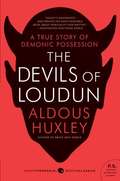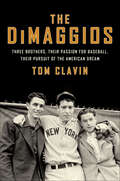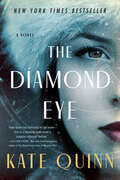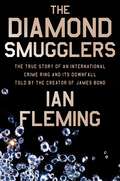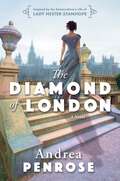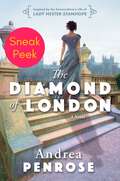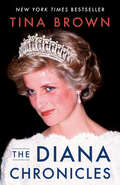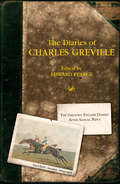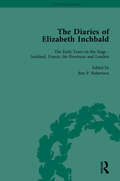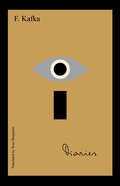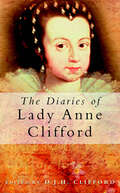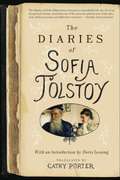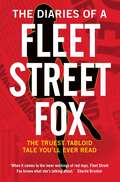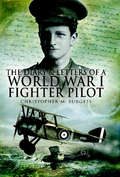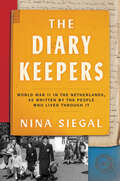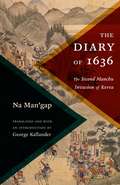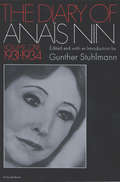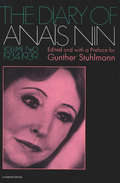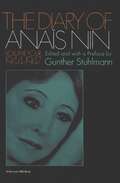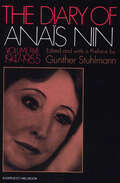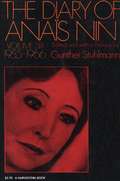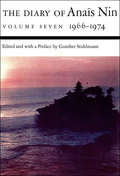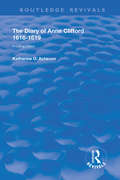- Table View
- List View
The Devils of Loudun
by Aldous HuxleyIn this classic nonfiction work by the legendary Aldous Huxley, a remarkable true story of religious and sexual obsession, considered a compelling historical event, is clarified and brought to vivid life.
The DiMaggios: Three Brothers, Their Passion for Baseball, Their Pursuit of the American Dream
by Tom ClavinThis biography of the legendary baseball family is an “entertaining and a rich source of DiMaggio lore” (New York Daily News).In The DiMaggios, New York Times–bestselling acclaimed sportswriter Tom Clavin reveals the untold Great American Story of three brothers, Joltin’ Joe, Dom, and Vince DiMaggio, and the Great American Game—baseball—that would consume their lives.A vivid portrait of a family and the ways in which their shifting fortunes and status shaped their relationships, The DiMaggios is an exploration of an era and a culture.This comprehensive biography offers a trove of insight into one of the game’s greatest players and his family, sure to be treasured by Yankees fans, Red Sox Fans, and baseball aficionados around the world.“Fascinating revelations . . . more than the story of three ball playing brothers.” —Boston Globe
The Diamond Eye: A Novel
by Kate QuinnDon’t miss the thrilling new novel from Kate Quinn, The Briar Club, coming July 9th! New York Times BestsellerThe bestselling author of The Rose Code returns with an unforgettable World War II tale of a quiet bookworm who becomes history’s deadliest female sniper. Based on a true story.In 1937 in the snowbound city of Kyiv, wry and bookish history student Mila Pavlichenko organizes her life around her library job and her young son—but Hitler’s invasion of Ukraine and Russia sends her on a different path. Given a rifle and sent to join the fight, Mila must forge herself from studious girl to deadly sniper—a lethal hunter of Nazis known as Lady Death. When news of her three hundredth kill makes her a national heroine, Mila finds herself torn from the bloody battlefields of the eastern front and sent to America on a goodwill tour.Still reeling from war wounds and devastated by loss, Mila finds herself isolated and lonely in the glittering world of Washington, DC—until an unexpected friendship with First Lady Eleanor Roosevelt and an even more unexpected connection with a silent fellow sniper offer the possibility of happiness.But when an old enemy from Mila’s past joins forces with a deadly new foe lurking in the shadows, Lady Death finds herself battling her own demons and enemy bullets in the deadliest duel of her life.Based on a true story, The Diamond Eye is a haunting novel of heroism born of desperation, of a mother who became a soldier, of a woman who found her place in the world and changed the course of history forever.
The Diamond Smugglers: The True Story of an International Crime Ring and Its Downfall, Told by the Creator of James Bond
by Ian FlemingTHE TRUE STORY OF AN INTERNATIONAL CRIME RING AND ITS DOWNFALLIn 1957, as the Cold War raged, Ian Fleming took a respite from writing James Bond to craft a work of nonfiction every bit as tense as a Bond adventure. Aided by an ex-MI5 agent and International Diamond Security Organization operative going by the alias “John Blaize,” Fleming chronicled the IDSO’s infiltration of the “million-carat network”―the world’s most notorious diamond smuggling ring.Every year, a shadowy band of racketeers pirated a fortune in diamonds out of Africa, and the majority of the stolen gems wound up in the hands of Communist nations. In response, the IDSO commissioned a private army, led by legendary British spymaster Sir Percy Sillitoe, to penetrate and topple the ring.When the operation was complete, the Sunday Times gave the story to Fleming, who had impressed Sillitoe with his earlier Bond adventure Diamonds Are Forever. A remarkable feat of investigative journalism, The Diamond Smugglers is the thrilling true story behind one of the greatest spy operations in history.
The Diamond of London: A Fascinating Historical Novel of the Regency Based on True History
by Andrea Penrose"What a life Lady Hester had!...Simply sparkles!&” —Kate Quinn, New York Times Bestselling Author of The Diamond Eye Fans of Shana Abé, Theresa Ann Fowler, and Fiona Davis will be captivated by the unforgettable spirit at the heart of USA Today bestselling author Andrea Penrose&’s dazzling new historical novel based on the real life of Lady Hester Stanhope (1776-1839), a British aristocrat, antiquarian, and adventurer who defied all conventional strictures of what a woman could and couldn&’t do during the Regency era.&“Andrea Penrose&’s impeccable research and attention to detail brings this unique and fascinating historical figure to sparkling life.&” —Christine Wells, author of The Royal Windsor Secret&“A truly dazzling read!&” —Eliza Knight, USA Today and international bestselling author of Starring Adele AstaireBorn into an illustrious family of swashbuckling war heroes and brilliant political leaders, Lady Hester Stanhope was a Regency-era adventuress who lived on her own terms and refused to conform. Even with her privileged life, Lady Hester Stanhope knows that claiming the adventurous life she truly wants will not be easy, thanks to her eccentric father&’s stifling grip. With the help of her renowned statesman uncle William Pitt the Younger, she takes on the glittering, treacherous heights of London Society. Her formidable intelligence, outspoken opinions, and headstrong determination gain the favor of the beau monde&’s leading taste-maker Beau Brummell—and she quickly learns to bend the rules of the ton to her own advantage. And as her uncle&’s hostess, she astutely uses her skills to preside over—and give advice to—the most influential figures of her day, rising to a position unequaled in society . . . But when it comes to holy matrimony, Hester will settle for no less than a passionate match of equals—a search marked by challenges and heartbreak. Her affair with a charismatic naval officer tempts her with forbidden pleasures—even as it threatens her reputation. Her love for a sophisticated, brilliant diplomat offers the marriage of her dreams . . . and unsuspected betrayal. And as England is plunged into war, Hester&’s world changes forever, causing her to find courage and strength amid loss, chart a completely unexpected future—and make a glorious legacy forever hers . . .
The Diamond of London: Sneak Peek
by Andrea PenroseBe one of the first to read this sneak preview sample edition before the full length novel comes out!Born into an illustrious family of swashbuckling war heroes and brilliant political leaders, Lady Hester Stanhope was a Regency-era adventuress who lived on her own terms and refused to conform.Fans of Shana Abé, Theresa Ann Fowler, and Fiona Davis will be captivated by the unforgettable spirit at the heart of USA Today bestselling author Andrea Penrose&’s dazzling new historical novel based on the real life of Lady Hester Stanhope (1776-1839), a British aristocrat, antiquarian, and adventurer who defied all conventional strictures of what a woman could and couldn&’t do during the Regency era.Even with her privileged life, Lady Hester Stanhope knows that claiming the adventurous life she truly wants will not be easy, thanks to her eccentric father&’s stifling grip. With the help of her renowned statesman uncle William Pitt the Younger, she takes on the glittering, treacherous heights of London Society. Her formidable intelligence, outspoken opinions, and headstrong determination gain the favor of the beau monde&’s leading taste-maker Beau Brummell—and she quickly learns to bend the rules of the ton to her own advantage. And as her uncle&’s hostess, she astutely uses her skills to preside over—and give advice to—the most influential figures of her day, rising to a position unequaled in society . . .But when it comes to holy matrimony, Hester will settle for no less than a passionate match of equals—a search marked by challenges and heartbreak. Her affair with a charismatic naval officer tempts her with forbidden pleasures—even as it threatens her reputation. Her love for a sophisticated, brilliant diplomat offers the marriage of her dreams . . . and unsuspected betrayal. And as England is plunged into war, Hester&’s world changes forever, causing her to find courage and strength amid loss, chart a completely unexpected future—and make a glorious legacy forever hers . . .
The Diana Chronicles
by Tina Brown#1 NEW YORK TIMES BESTSELLER • Years after her death, Princess Diana remains a mystery. This "insanely readable and improbably profound" biography (Chicago Tribune) reveals the truth as only famed journalist Tina Brown could tell it. "The best book on Diana." —The New YorkerWas she &“the people&’s princess,&” who electrified the world with her beauty and humanitarian missions? Or was she manipulative and media-savvy and nearly brought down the monarchy? Tina Brown, former Editor-in-Chief of Tatler, England&’s glossiest gossip magazine; Vanity Fair; and The New Yorker gives us the answers. Tina knew Diana personally and has far-reaching insight into the royals and the Queen herself.In The Diana Chronicles, you will meet a formidable female cast and understand as never before the society that shaped them: Diana's sexually charged mother, her scheming grandmother, the stepmother she hated but finally came to terms with, and bad-girl Fergie, her sister-in-law, who concealed wounds of her own. Most formidable of them all was her mother-in-law, the Queen, whose admiration Diana sought till the day she died. Add Camilla Parker-Bowles, the ultimate "other woman" into this combustible mix, and it's no wonder that Diana broke out of her royal cage into celebrity culture, where she found her own power and used it to devastating effect.
The Diaries Of Charles Greville
by Edward PearceCharles Greville (1794-1865) made his first occasional diary entries in 1814, but the diary only became a regular habit in the mid-1820s, continuing with occasional breaks, about which he is self-reproachful, through the reigns of George IV, William IV and Victoria. Finally, in 1860, after shaking his head over the worrying triumphs of Garibaldi, he closed it, once and for all. The grandson of a duke, Greville looked with a level and scornful eye upon royalty. George was 'the most worthless dog that ever lived'; William 'the silliest old gentleman in his own dominions, but what can be expected of a man with a head like a pineapple?' The diaries roused Queen Victoria - 'an odd woman' - from the lethargy of her widowhood.She spoke of Greville's 'indiscretion, indelicacy, ingratitude toward friends, betrayal of confidence and shameful disloyalty'.Greville's circle included Talleyrand, Wellington, Macaulay, Sydney Smith, Princess Lieven, Lord Grey, Melbourne, Guizot and Disraeli, as well as 'jockeys, bookmakers and blackguards'.As Clerk of the Privy Council, Greville works for a compromise on the Reform Bill.He witnesses Covent Garden theatre burning down.His closest friend, Lord De Ros, is caught cardsharping. Visiting Balmoral, he finds Albert and Victoria living 'not merely like small gentlefolks, but like very small gentlefolks'. When cholera comes, he writes laconically of 'Mrs Smith, young and beautiful, taken ill while dressing for Church and dead by nightfall.' Not a chatterbox, Charles Greville brilliantly assembles everyone else's chatter. This is the intelligent voice of another age, an uneasy aristocrat catching history on the turn and looking dubiously at the future.
The Diaries of Elizabeth Inchbald Vol 1
by Ben P RobertsonAn energetic woman, Inchbald achieved fame as an actress, novelist, playwright and critic. This work includes her eleven surviving diaries, which record Inchbald's social contacts and professional activities, itemize her day-to-day expenditure, and chart the development of affairs such as the Napoleonic Wars and the trial of Queen Caroline.
The Diaries of Franz Kafka (The Schocken Kafka Library)
by Franz KafkaAn essential new translation of the author&’s complete, uncensored diaries—a revelation of the idiosyncrasies and rough edges of one of the twentieth century&’s most influential writers. "This new and scrupulously faithful translation of the Diaries brings us...the true inner life of the twentieth century&’s most complex and enigmatic literary prophet." —Cynthia Ozick, author of AntiquitiesDating from 1909 to 1923, the handwritten diaries contain various kinds of writing: accounts of daily events, reflections, observations, literary sketches, drafts of letters, accounts of dreams, as well as finished stories. This volume makes available for the first time in English a comprehensive reconstruction of the diary entries and provides substantial new content, including details, names, literary works, and passages of a sexual nature that were omitted from previous publications. By faithfully reproducing the diaries&’ distinctive—and often surprisingly unpolished—writing in Kafka&’s notebooks, translator Ross Benjamin brings to light not only the author&’s use of the diaries for literary experimentation and private self-expression, but also their value as a work of art in themselves.
The Diaries of Lady Anne Clifford
by D.J.H CliffordNoblewoman, vividly documents both the great and the trivial events of her long life. They cover her life from her childhood days, when she witnessed the funeral of Queen Elizabeth I, to her last months, when she recalled her past from her room in Brougham Castle. Through compiling and transcribing the manuscript records, D.J.H. Clifford here presents in one volume the full range of Lady Anne's life: her active role at court as the Countess of Dorset (residing at Knole in Kent), her turbulent second marriage to the 4th Earl of Pembroke at Wilton Wiltshire, and her final, long-disputed succession to her father's lands in Westmorland and North Yorkshire. The diaries are complemented by explanatory notes, family trees and illustrations. They provide both an important historical record and an intriguing glimpse into the and character of this noble and Christian lady, whose powerful presence is still in evidence today in the monuments and folklore of Westmorland.
The Diaries of Sofia Tolstoy
by Cathy PorterAfter marrying Count Leo Tolstoy, the renowned author of Anna Karenina and War and Peace, Sofia Tolstoy kept a detailed diary until his death in 1910. Her life was not an easy one: she idealized her husband but was tormented by him. She lived against the background of one of the most turbulent periods in her country's history, as old feudal Russia was transformed by three revolutions and three major international wars. Yet it is as Sofia Tolstoy's own life story-the study of one woman's private experience-that these diaries are most valuable and moving. They reveal a woman of tremendous vital energy and poetic sensibility who, in the face of provocation and suffering, continued to strive for the higher things in life and to remain indomitable.
The Diaries of a Fleet Street Fox
by Lilly MilesSEX, DRUGS, HEARTBREAK AND SCANDAL - THE INNER WORKINGS OF A TABLOID NEWSROOMFleet Street Fox's anonymity allows her to delve deep into the dark corners of that most guilty of pleasures - the tabloid exposé. Acerbic, funny, and revelatory, her diaries show the heart within the hack as she tries to recover from a betrayal as devastating as any newspaper scandal.Now an internet smash, with over forty thousand followers on twitter, two hugely popular blogs and a reputation throughout the media industry, Foxy's diaries are juicy, shocking and as near to the knuckle as the lawyers would allow. The Diaries of a Fleet Street Fox tells the truth about her trade: the private scandals, victories and disasters that don't end up on the front page. This is the hardest story she has ever told.
The Diary And Letters Of A World War 1 Fighter Pilot
by Christopher M. BurgessThis is a first-hand account of the authors grandfather, Guy Mainwaring Knocker and his experiences as a pilot in the R.F.C. in the First World War written as a series of letters and diary entries. He wrote letters virtually every day to his family, while he trained in England and was in service in France, and often illustrated them with little sketches. Guy was a gifted artist, particularly pencil and Pen & ink, and also an excellent photographer. He flew with No 65 (Fighter) Squadron that was formed in June, 1916 as a fighter squadron, and flew to France in March 1917 in time to play a prominent part in the air operations during the Battles of Arras. In June 1917, the squadron moved to Calais for special patrol work in the Dover Straits area, to intercept enemy aircraft raiding England.
The Diary Keepers: World War II in the Netherlands, as Written by the People Who Lived Through It
by Nina SiegalA riveting look at the story of World War II and the Holocaust through the diaries of Dutch citizens, firsthand accounts of ordinary people living through extraordinary times Based on select writings from a collection of more than two thousand Dutch diaries written during World War II in order to record this unparalleled time, and maintained by devoted archivists, The Diary Keepers illuminates a part of history we haven’t seen in quite this way before, from the stories of a Nazi sympathizing police officer to a Jewish journalist who documented daily activities at a transport camp.Journalist Nina Siegal, who grew up in a family that had survived the Holocaust in Europe, had always wondered about the experience of regular people during World War II. She had heard stories of the war as a child and Anne Frank’s diary, but the tales were either crafted as moral lessons — to never waste food, to be grateful for all you receive, to hide your silver — or told with a punch line. The details of the past went untold in an effort to make it easier assimilate into American life.When Siegal moved to Amsterdam as an adult, those questions came up again, as did another horrifying one: Why did seventy five percent of the Dutch Jewish community perish in the war, while in other Western European countries the proportions were significantly lower? How did this square with the narratives of Dutch resistance she had heard so much about and in what way did it relate to the famed tolerance people in the Netherlands were always talking about? Perhaps more importantly, how could she raise a Jewish child in this country without knowing these answers?Searching and singular, The Diary Keepers mines the diaries of ordinary citizens to understand the nature of resistance, the workings of memory, and the ways we reflect on, commemorate, and re-envision the past.
The Diary Of A Cavalry Officer In The Peninsular And Waterloo Campaigns, 1809 - 1815
by Pickle Partners Publishing Rt. Hon. James Tomkinson Lieutenant-Colonel William TomkinsonThis ebook is purpose built and is proof-read and re-type set from the original to provide an outstanding experience of reflowing text for an ebook reader. Lieutenant Colonel Tomkinson's memoirs are a rarity amongst the many books written by British soldiers of their experiences during the Napoleonic period, in that it has been written by a cavalryman. This in itself makes the book interesting, but the author was also a witness to many of the pivotal engagements of the Peninsular War and Waterloo. He was present at the sieges of Badajoz, Cuidad Rodrigo, and San Sebastian, the battles of Busaco, Fuentes de Oñoro, Salamanca and Vitorria. His work is often quoted in histories of the Waterloo campaign which offers much to the casual reader or the serious historian. Perhaps most striking about Tomkinson's text is the detailed notes that he must have taken contemporaneously are melded into a flowing account of his service. The detail of the marches and orders of battle are interspersed with anecdotes and insights. Includes Linked TOC Original Text taken from the 1894 edition published by Swan Sonnenschein, London. Author - Lt.-Col William Tomkinson (1790-1872) Foreword - Rt. Hon. James Tomkinson (1840-1910) Illustrations - Numerous maps and Illustrations Annotations - Pickle Partners Publishing
The Diary of 1636: The Second Manchu Invasion of Korea (Translations from the Asian Classics)
by Na Man’gap and George KallanderEarly in the seventeenth century, Northeast Asian politics hung in a delicate balance among the Chosŏn dynasty in Korea, the Ming in China, and the Manchu. When a Chosŏn faction realigned Korea with the Ming, the Manchu attacked in 1627 and again a decade later, shattering the Chosŏn-Ming alliance and forcing Korea to support the newly founded Qing dynasty.The Korean scholar-official Na Man’gap (1592–1642) recorded the second Manchu invasion in his Diary of 1636, the only first-person account chronicling the dramatic Korean resistance to the attack. Partly composed as a narrative of quotidian events during the siege of Namhan Mountain Fortress, where Na sought refuge with the king and other officials, the diary recounts Korean opposition to Manchu and Mongol forces and the eventual surrender. Na describes military campaigns along the northern and western regions of the country, the capture of the royal family, and the Manchu treatment of prisoners, offering insights into debates about Confucian loyalty and the conduct of women that took place in the war’s aftermath. His work sheds light on such issues as Confucian statecraft, military decision making, and ethnic interpretations of identity in the seventeenth century. Translated from literary Chinese into English for the first time, the diary illuminates a traumatic moment for early modern Korean politics and society. George Kallander’s critical introduction and extensive annotations place The Diary of 1636 in its historical, political, and military context, highlighting the importance of this text for students and scholars of Chinese and East Asian as well as Korean history.
The Diary of Anais Nin Volume 1 1931-1934: Vol. 1 (1931-1934) (The Diaries of Anaïs Nin #1)
by Anaïs Ninnais Nin's novels' and stories, acclaimed at first only by the literary community, have gained a steadily growing audience over the years. Today, her works, which baffled readers by their unique subtlety and dreamlike precision, are translated into eight languages and are acclaimed throughout the world. But her true life work, rumor had it, was contained in the enormous diary Miss Nin has kept since her childhood. And those who had seen glimpses of the diary reported that it would be one of the outstanding literary and biographical documents of our time. Its publication has been long awaited. Here now is the first volume of this diary. It is as clear, as direct, as beautifully honest and simple as writing may be. It covers Miss Nin's life in Paris during the early 1930's. It provides full-length portraits of the then unknown Henry Miller, of the extraordinary surrealist poet and man of the theater Antonin Artaud, of the famous psychiatrist Dr. Otto Rank, and of many others. And it offers a fascinating record of Miss Nin's struggles to discover her own self, to come to grips with her past and her future. The intensity, the clarity, the sensitive vision that inform these pages make them extraordinary, accessible and stimulating.
The Diary of Anaïs Nin, 1934–1939: 1934–1939 (The Diaries of Anaïs Nin #2)
by Anaïs NinThe second volume of &“one of the most remarkable diaries in the history of letters&” (Los Angeles Times). Beginning with the author&’s arrival in New York, this diary recounts Anaïs Nin&’s work as a psychoanalyst, and is filled with the stories of her analytical patients—as well as her musings over the challenges facing the artist in the modern world. The diary of this remarkably daring and candid woman provides a deeply intimate look inside her mind, as well as a fascinating chapter in her tumultuous life in the latter years of the 1930s.
The Diary of Anaïs Nin, 1939–1944: 1939-1944 (The Diaries of Anaïs Nin #3)
by Anaïs NinThe third volume of &“one of the most remarkable diaries in the history of letters&” (Los Angeles Times). This candid volume from the renowned diarist covers her years of struggle, and eventual triumph, as an author in America during World War II. &“Transcending mere self-revelation . . . the diary examines human personality with a depth and understanding seldom surpassed since Proust . . . dream and fact are balanced and . . . in their joining lie the elements of masterpiece.&” —The Washington Post &“Just one page of Nin&’s extraordinary diaries contains more sex, melodrama, fantasies, confessions, and observations than most novels, and reflects much about the human psyche we strive to repress.&” —Booklist Edited and with a preface by Gunther Stuhlmann
The Diary of Anaïs Nin, 1944–1947 (The Diaries of Anaïs Nin #4)
by Anaïs NinThe fourth volume of &“one of the most remarkable diaries in the history of letters&” (Los Angeles Times). The renowned diarist continues her record of her personal, professional, and artistic life, recounting her experiences in Greenwich Village for several years in the late 1940s, where she defends young writers against the Establishment—and her trip across the country in an old Ford to California and Mexico. &“[Nin is] one of the most extraordinary and unconventional writers of [the twentieth] century.&” —The New York Times Book Review Edited and with a preface by Gunther Stuhlmann
The Diary of Anaïs Nin, 1947–1955: 1947–1955 (The Diaries of Anaïs Nin #5)
by Anaïs NinThe fifth volume of &“one of the most remarkable diaries in the history of letters&” (Los Angeles Times). Spanning from the late 1940s through the mid-1950s, this volume covers the author&’s experiences in Mexico, California, New York, and Paris; her psychoanalysis; and her experiment with LSD. &“Through her own struggling and dazzling courage [Nin has] shown women . . . groping with and growing with the world.&” —Minneapolis Tribune Edited and with a preface by Gunther Stuhlmann
The Diary of Anaïs Nin, 1955–1966 (The Diaries of Anaïs Nin #6)
by Anaïs NinThe sixth volume of the diary of &“one of the most extraordinary and unconventional writers of [the twentieth] century&” (The New York Times Book Review). Anaïs Nin continues &“one of the most remarkable diaries in the history of letters&” with this volume covering more than a decade of her midcentury life (Los Angeles Times). She debates the use of drugs versus the artist&’s imagination; portrays many famous people in the arts; and recounts her visits to Sweden, the Brussels World&’s Fair, Paris, and Venice. &“[Nin] looks at life, love, and art with a blend of gentility and acuity that is rare in contemporary writing.&” —John Barkham Reviews Edited and with a preface by Gunther Stuhlmann
The Diary of Anaïs Nin, 1966–1974: 1966–1974 (The Diaries of Anaïs Nin #7)
by Anaïs NinThe seventh and final volume of the author&’s &“remarkable&” diary is filled with the reflections of an older woman as she journeys through the world (Los Angeles Times). &“One of the most remarkable diaries in the history of letters&” ends as the author wished: not with her last two years of pain but at a joyous moment on a trip to Bali (Los Angeles Times). As she ages, Anaïs Nin reflects on how the deeply personal and introspective nature of her writings intertwines with her public life and her connections with other people, including her devoted readers. &“One of the most extraordinary and unconventional writers of [the twentieth] century.&” —The New York Times Book Review Edited and with a preface by Gunther Stuhlmann
The Diary of Anne Clifford 1616-1619: A Critical Edition (Routledge Revivals)
by Katherine O. AchesonOriginally published in 1995, this book contains a full version of The Diary of Anne Clifford, alongisde an introduction and textual notes. Anne Clifford left one of the most extensive autobiographical records of the seventeenth century and, it was first published, this edition was the first critical edition of any of her works.
